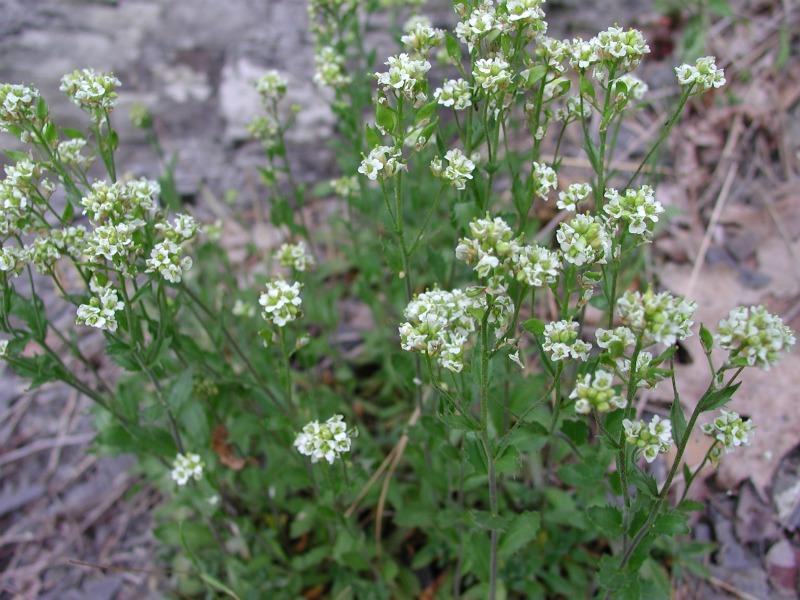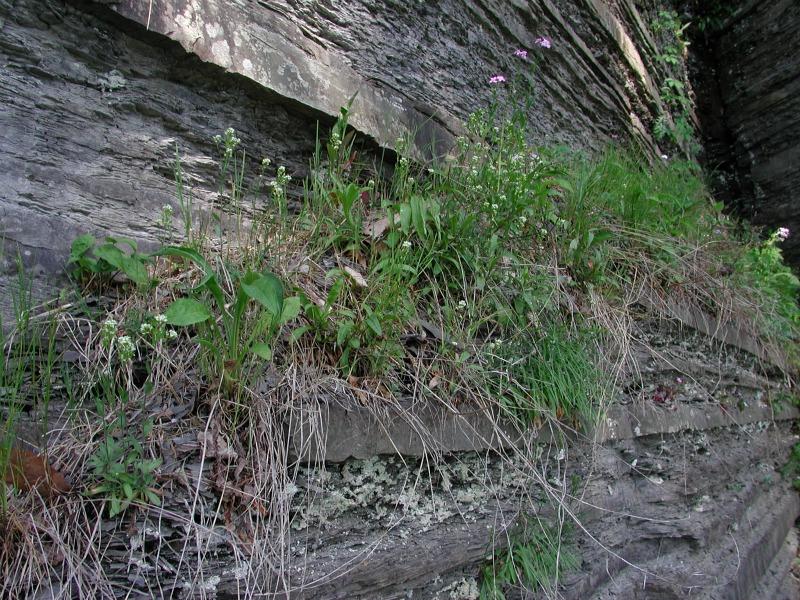Rock Whitlow Grass
Draba arabisans Michx.
- Class
- Dicotyledoneae (Dicots)
- Family
- Brassicaceae (Mustard Family)
- State Protection
- Threatened
Listed as Threatened by New York State: likely to become Endangered in the foreseeable future. For animals, taking, importation, transportation, or possession is prohibited, except under license or permit. For plants, removal or damage without the consent of the landowner is prohibited.
- Federal Protection
- Not Listed
- State Conservation Status Rank
- S2
Imperiled in New York - Very vulnerable to disappearing from New York due to rarity or other factors; typically 6 to 20 populations or locations in New York, very few individuals, very restricted range, few remaining acres (or miles of stream), and/or steep declines.
- Global Conservation Status Rank
- G4G5
Apparently or Demonstrably Secure globally - Uncommon to common in the world, but not rare; usually widespread, but may be rare in some parts of its range; possibly some cause for long-term concern due to declines or other factors. More information is needed to assign either G4 or G5.
Summary
Did you know?
Whitlow grass was the European name given to several inconspicuous wildflowers such as Saxifraga tridactylites, Draba verna and Paronychia which were thought to be a cure for the Whitlow. This is an infection of the end of the fingers and toes around the nail, as well as the hooves of animals, which caused painful inflammation. The genus Draba is from the Greek "drabe", meaning sharp or acrid, and refers to the burning taste of the leaves of these medicinal plants. Draba arabisans may be told from its closest New York relative, Draba glabella, by its twisted fruit and longer styles.
State Ranking Justification
There are only 12 verified locations, with many historical locations remaining to be checked. This species is relatively inconspicuous and may occupy inaccessible habitats, and therefore may be overlooked.
Short-term Trends
Most currently known populations are small and persistent, but accurate and recent counts are lacking.
Long-term Trends
Many historical locations have not been observed for more than 25 years.
Conservation and Management
Threats
Most sites for this species are cliffs, and therefore relatively free from the threat of human disturbance; deer herbivory, fire, and succession may threaten some locations.
Conservation Strategies and Management Practices
A buffer should be maintained around populations of this plant.
Research Needs
Research could help determine the reasons for the rarity of this species in New York and adjacent states.
Habitat
Habitat
Draba arabisans grows on dry cliffs, rocky ledges, talus slopes and open woodlands, often at calcareous sites. In New York Draba arabisans has been found on bedrock of limestone, shale and siltstone, and anorthosite. (New York Natural Heritage Program 2007). Rocks and cliffs (Gleason and Cronquist 1991).
Associated Ecological Communities
- Alvar pavement grassland*
(guide)
This community consists of exposed, flat limestone or dolostone pavement with grassy or mossy patches interspersed throughout. Some examples may be solely grassland with no pavement.
- Calcareous cliff community
(guide)
A community that occurs on vertical exposures of resistant, calcareous bedrock (such as limestone or dolomite) or consolidated material; these cliffs often include ledges and small areas of talus.
- Calcareous shoreline outcrop
(guide)
A community that occurs along the shores of lakes and streams on outcrops of calcareous rocks such as limestone and dolomite. The vegetation is sparse; most plants are rooted in rock crevices.
- Cliff community
(guide)
A community that occurs on vertical exposures of resistant, non-calcareous bedrock (such as quartzite, sandstone, or schist) or consolidated material; these cliffs often include ledges and small areas of talus.
- Ice cave talus community*
(guide)
A community that occurs on rocks and soil at the base of slopes of loose rocks (often below cliffs; these are talus slopes) that emit cold air. The emission of cold air results from air circulation among the rocks of the talus slope where winter ice remains through the summer. The vegetation is distinctive because it includes species characteristic of climates much cooler than the climate of the area where the ice caves occur.
- Limestone woodland
(guide)
A woodland that occurs on shallow soils over limestone bedrock in non-alvar settings, and usually includes numerous rock outcrops. There are usually several codominant trees, although one species may become dominant in any one stand.
- Northern white cedar rocky summit*
(guide)
A community that occurs on cool, dry, rocky ridgetops and summits where the bedrock is calcareous (such as limestone or dolomite), and the soils are more or less calcareous. The vegetation may be sparse or patchy, with numerous rock outcrops. The species have predominantly boreal distributions.
- Oak openings
(guide)
A grass-savanna community that occurs on well-drained soils. In New York, these savannas originally occurred as openings within extensive oak-hickory forests. The best remnants occur on dolomite knobs.
- Red cedar rocky summit*
(guide)
A community that occurs on warm, dry, rocky ridgetops and summits where the bedrock is calcareous (such as limestone or dolomite, but also marble, amphibolite, and calcsilicate rock), and the soils are more or less calcareous. The vegetation may be sparse or patchy, with numerous lichen covered rock outcrops.
- Roadcut cliff/slope*
A sparsely vegetated cliff or steep slope, along a road, that was created by blasting or digging during road construction.
- Shale cliff and talus community
(guide)
A community that occurs on nearly vertical exposures of shale bedrock and includes ledges and small areas of talus. Talus areas are composed of small fragments that are unstable and steeply sloping; the unstable nature of the shale results in uneven slopes and many rock crevices.
- Spruce-fir rocky summit*
(guide)
A community that occurs on cool, dry, rocky ridgetops and summits where the bedrock is non-calcareous (such as anorthosite, quartzite, or sandstone), and the soils are more or less acidic. The vegetation may be sparse or patchy, with numerous rock outcrops and rock slides. The species have predominantly boreal distributions.
* probable association but not confirmed.
Associated Species
- Acer pensylvanicum (striped maple)
- Acer spicatum (mountain maple)
- Anaphalis margaritacea (pearly everlasting)
- Carex communis
- Carex laxiflora (loose-flowered sedge)
- Clintonia borealis (blue bead-lily)
- Cornus alternifolia (pagoda dogwood, alternate-leaved dogwood)
- Cornus rugosa (round-leaved dogwood)
- Deschampsia flexuosa
- Diervilla lonicera (bush-honeysuckle)
- Minuartia groenlandica
- Muhlenbergia glomerata (spike muhly)
- Ostrya virginiana (hop hornbeam, ironwood)
- Parthenocissus quinquefolia (Virginia-creeper)
- Pellaea glabella
- Quercus sp
- Rubus idaeus
- Saxifraga paniculata
- Saxifraga virginiensis
- Solidago hispida (hairy goldenrod)
- Solidago rugosa
- Thuja occidentalis (northern white cedar, arbor vitae)
- Tiarella cordifolia (foamflower)
- Woodsia ilvensis (rusty woodsia, rusty cliff fern)
Range
New York State Distribution
There are scattered populations across the state, excluding Long Island and the lower Hudson Valley.
Global Distribution
Draba arabisans occurs in the northeastern U.S. and eastern Canada, from Minnesota and Ontario in the west, across the Upper Great Lakes states, Ontario, and New York to northern New England (but excluding New Hampshire) Quebec, and Labrador. New York is on the southern boundary of its range.
Identification Comments
General Description
Draba arabisans is a small (4 to 16 inches tall) herbaceous perennial, growing from a hardened base just underground (a caudex) to a basal rosette of hairy, 2.5 inch-long leaves, often dentate. From the rosette grows a single stem with a few dentate leaves and a loose terminal raceme up to 4 inches long, bearing 4-petaled flowers, the petals are yellow in bud but white upon opening. These mature into a flattened, lance-shaped fruit called a silique. The fruit are flattened, glabrous, and about 1/4 to 1/2 inch long.
Identifying Characteristics
Draba arabisans is a sturdy perennial growing from a thick caudex, 1-4dm tall, with many basal but few cauline leaves, the basal leaves narrowly oblanceolate to spatulate, up to 6cm long, often sharply toothed, and stellate -hairy. The stellate hairs are sessile and have 8 or fewer rays. The infloresence is a loose raceme up to 10 cm long, the pedicels without leaves or bracts, and glabrous or nearly so. The petals appear yellow in bud but are white after opening, and 4-6mm long. The persistent style is .3 to .8 mm long. The fruits are glabrous siliques, 7 -12 mm long and .2x to .25 x as wide as long, lanceolate to narrowly oblong, twisting during maturation, but shorter, ovate, and straight in depauperate specimens.
Best Life Stage for Proper Identification
Draba arabisans is most easily identified when it is flowering, this occurs from late May through early July, depending on site (and microsite) conditions. Fruiting individuals can also be keyed successfully.
Similar Species
New York has 3 other species of Draba. Draba verna, an exotic species, is an annual, more slender than D. arabisans, with deeply split petals. D. reptans is also a slender annual, with entire basal leaves 3 cm long or less, shorter than the sharply toothed basal leaves of D. arabisans, which may reach 6cm. Both of these species are typically found in sandy or disturbed habitats. The only other perennial Draba in New York, which like D. arabisans is found on cliffs and rocks, is Draba glabella. Very similar to D. arabisans, D. glabella has untwisted fruits, typically .25x to .4x as wide as long, with the style obsolete or only 0.1 to 0.3mm, and its leaves have stellate hairs that are stalked and with 9 or more rays. So far it is known in New York only from Washington and Clinton counties in the northeast.
Best Time to See
Draba arabisans flowers from late May until late June, with fruits visible usually through the beginning of October. Individual plants may be found with flowers at the top of the infloresence and developing fruit below, which may be helpful in identification.
- Flowering
- Fruiting
The time of year you would expect to find Rock Whitlow Grass flowering and fruiting in New York.
Rock Whitlow Grass Images
Taxonomy
Rock Whitlow Grass
Draba arabisans Michx.
- Kingdom Plantae
- Phylum Anthophyta
- Class Dicotyledoneae
(Dicots)
- Order Capparales
- Family Brassicaceae (Mustard Family)
- Order Capparales
- Class Dicotyledoneae
(Dicots)
- Phylum Anthophyta
Additional Common Names
- Rock Draba
- Whitlow-grass
Additional Resources
References
Gleason, Henry A. and A. Cronquist. 1991. Manual of Vascular Plants of Northeastern United States and Adjacent Canada. The New York Botanical Garden, Bronx, New York. 910 pp.
Holmgren, Noel. 1998. The Illustrated Companion to Gleason and Cronquist's Manual. Illustrations of the Vascular Plants of Northeastern United States and Adjacent Canada. The New York Botanical Garden, Bronx, New York.
New York Natural Heritage Program. 2010. Biotics database. New York Natural Heritage Program. New York State Department of Environmental Conservation. Albany, NY.
New York Natural Heritage Program. 2024. New York Natural Heritage Program Databases. Albany, NY.
Voss, E.G. 1985. Michigan Flora. Part II. Dicots (Saururaceae - Cornaceae). Cranbrook Institute of Science and University of Michigan Herbarium. Ann Arbor, Michigan. 724 pp.
Weldy, T. and D. Werier. 2010. New York flora atlas. [S.M. Landry, K.N. Campbell, and L.D. Mabe (original application development), Florida Center for Community Design and Research http://www.fccdr.usf.edu/. University of South Florida http://www.usf.edu/]. New York Flora Association http://newyork.plantatlas.usf.edu/, Albany, New York
Links
About This Guide
Information for this guide was last updated on: January 13, 2009
Please cite this page as:
New York Natural Heritage Program. 2024.
Online Conservation Guide for
Draba arabisans.
Available from: https://guides.nynhp.org/rock-whitlow-grass/.
Accessed July 26, 2024.

